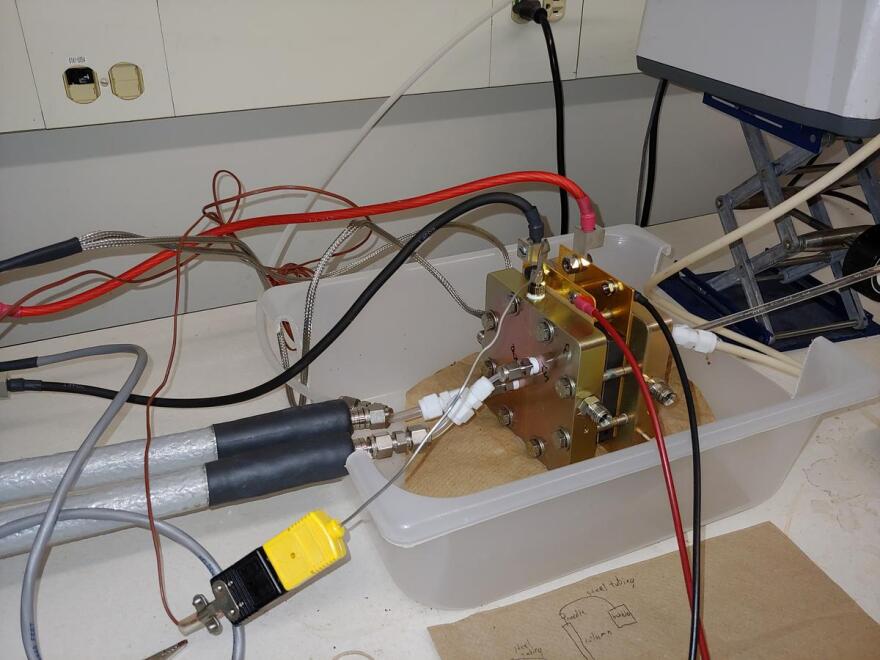Wisconsin scientists have made two breakthroughs that may help hydrogen become a bigger player in renewable energy production and storage. While the researchers say there's still a long way to go with their work, it's a step toward the "hydrogen economy" some were predicting nearly 20 years ago.
Fossil fuels like oil, natural gas and coal still power most of our cars, power plants and industries. Author Jeremy Rifkin was one of the most prominent early advocates of turning toward hydrogen, which pollutes the environment far less. Indeed, most scientists say its only by-product is water.
In a talk about his book "The Hydrogen Economy" in 2002, Rifkin sounded very optimistic: "There is a new energy regime on the horizon, and you can almost smell it. You can feel it. It, it's just there waiting. And it's hydrogen."
These days, hydrogen is getting more use as a fuel source. Some warehouses run forklifts powered by a device called a hydrogen fuel cell. A few car models sold in California, Japan and other parts of the world operate on hydrogen gas. But in many cases, fuel cells are too costly or inefficient. Or, the hydrogen is extracted from natural gas, which defeats the idea of reducing the use of fuels that contribute to global warming.
At a lab in the chemistry building at UW-Madison, researchers are trying to solve at least one of those problems — the cost, and they may be onto something. The small heart of the facility is the fuel cell.

Chemistry professor Shannon Stahl leads a team that designed a fuel cell using cheaper materials and a redesigned compound, which helps the flow of electrons and protons that convert chemical energy into electricity. He says the new process replaces the expensive metal platinum as the catalyst.
"Bypassing the need for platinum would be a major breakthrough. There are strategies that exist right now that are just not meeting the metrics that are needed. And so, conceiving of novel approaches, new strategies to overcome this limitation is really what we're trying to pursue in this project," Stahl said.
"Bypassing the need for platinum would be a major breakthrough," said Shannon Stahl.
Stahl says his research, published this month in the journal Joule, has found that cobalt — a lower-cost metal — can be used instead, with some modifications to the process.
He says there's still a ways to go. But Stahl says better fuel cells are worth pursuing, including to help store power from renewable sources like solar and wind energy, which fluctuate.
"Sometimes, you're going to have too much electricity that you're going to need to store. And so, fuel cells are among the many different approaches that are being considered for this surplus energy storage and then supply, when there's not the relevant energy available," Stahl said.
Another lab at UW-Madison is also reporting progress toward the hydrogen economy. A team led by Materials Science and Engineering professor Xudong Wang is part of an effort to use sunlight to split water into hydrogen and oxygen. Solar energy would be a much cleaner way to obtain hydrogen gas. But the team ran into a problem: the silicon panel used as the catalyst doesn't last long enough.

"It will be decaying in the water or liquid environment. So, we need to protect this material, and to extend its lifetime," Wang said.
Scientists usually coat the silicon with very thin amounts of titanium dioxide to extend its life. Wang has found that putting on even less of the coating can keep the silicon intact 600-700 hours, instead of the current 80. "So, this is sort of against common sense, that we make it thinner — [it] actually provides better protection," he said.
To make the technology useful commercially, scientists still need to find out how to extend the silicon's life to thousands of hours. Wang's research is published in the journal Nano Letters.
Both hydrogen-related projects were partly funded by the federal government under the Obama administration, and research into hydrogen and other fuels is continuing under President Donald Trump. This year, the Department of Energy awarded another $100 million for work at Energy Frontier Research Centers, including one involving UW-Madison.
Support is provided by Dr. Lawrence and Mrs. Hannah Goodman for Innovation reporting.

Do you have a question about innovation in Wisconsin that you'd like WUWM's Chuck Quirmbach to explore? Submit it below.
_




